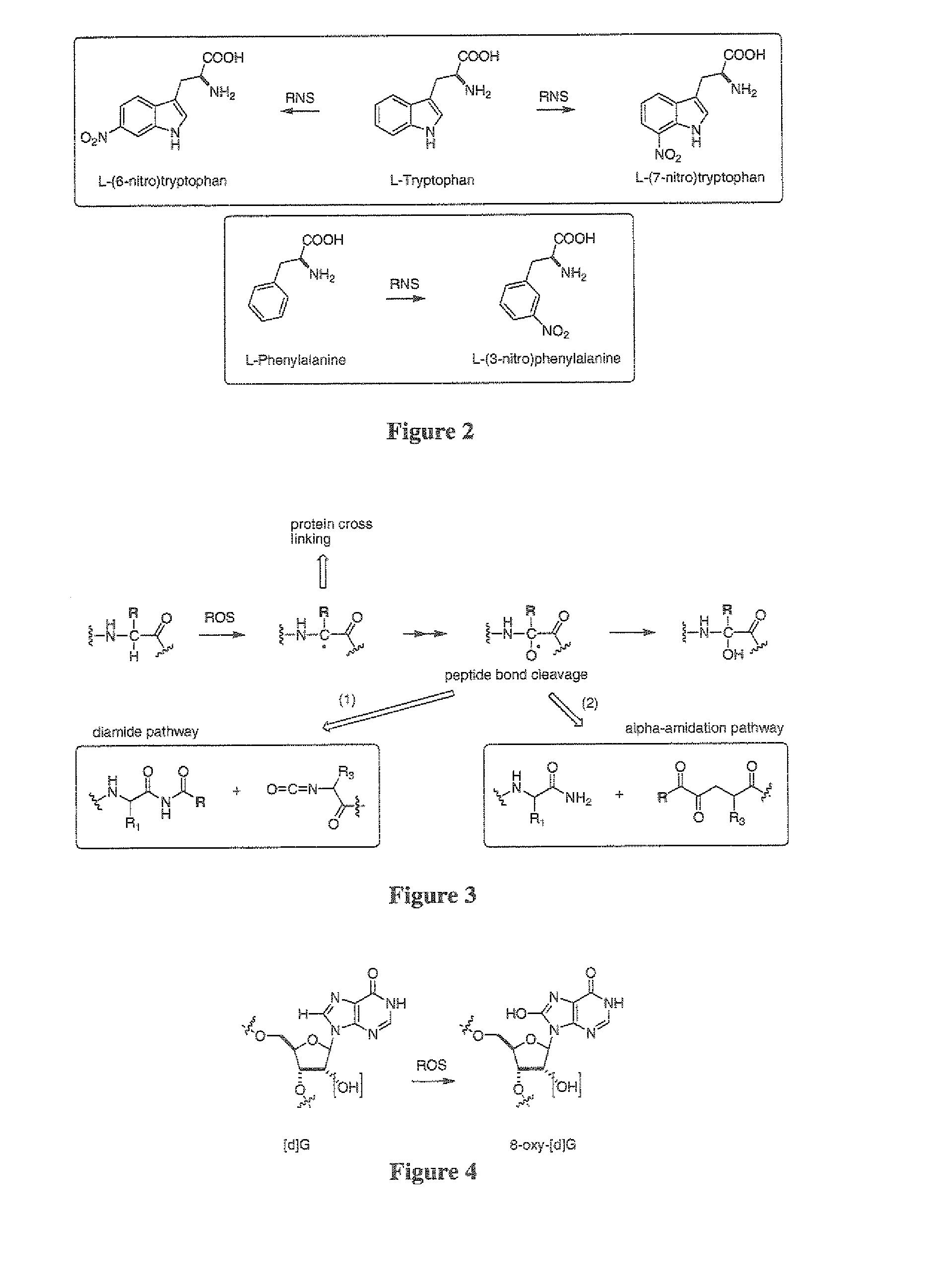Isotopically modified compounds and their use as food supplements
a technology of isotopically modified compounds and food supplements, which is applied in the direction of peptides, organic chemistry methods, drug compositions, etc., can solve the problems of protein oxidation, protein loss of catalytic or structural activity, and inability to repair by proteases, etc., to achieve the effect of resisting degradative processes
- Summary
- Abstract
- Description
- Claims
- Application Information
AI Technical Summary
Benefits of technology
Problems solved by technology
Method used
Image
Examples
example 1
(S)-2-Amino-4-cyano(13C)-butyric acid (a Precursor for 13C-Arg and 13C, 2H2-Arg)
[0050]
[0051]2.19 g (10 mmol) of N-Boc-homo-Serine (Bachem; desiccated overnight over P2O5) was dissolved in 10 ml of a mixture of acetonitrile / dimethylformamide (1:1). Dry Na13CN (Gas-Oil JSC, Russia; 1 g, 2 eqv) and NaI (10 mg, cat) were added, and the mixture was degassed. Me3SiCl (2.55 ml, 2 eqv) was then added with a syringe at RT under argon. The reaction mixture was stirred under argon at 60° C. for 6 h, with monitoring by TLC (chloroform / methanol 2:1, visualization in iodine vapor). Upon completion, the reaction mixture was cooled to RT, diluted with water (100 ml) and extracted with diethyl ether (2×50 ml). The organic phase was washed with water (4×50 ml) and brine (50 ml), dried (Na2SO4), decanted and concentrated in vacuo to yield (2.07 g, 91%) of colorless oil. The structure of the Boc-nitrile was confirmed by MALDI-TOF (Voyager Elite, PerSeptive Biosystems), with HPA as a matrix. Found: 229....
example 2
(S)-2-Amino-4-cyano-butyric acid (a Precursor for 2H2-Arg)
[0053]
[0054]4.93 g (20 mmol) of N-Boc-L-Glutamine (Sigma) was dissolved in 30 ml of anhydrous THF and added with stirring to a mixture of triphenylphosphine (10.49 g, 40 mmol, Aldrich) and 40 ml of anhydrous tetrachloromethane. The reaction mixture was stirred with gentle heating for 3 h (control by TLC, chloroform / methanol 2:1, visualization in iodine vapour), cooled and the precipitate of triphenylphosphine oxide filtered off. The oil obtained upon evaporation and re-evaporation with an additional 15 ml of THF was diluted with 30 ml of water. The aqueous fraction was saturated with brine, washed with diethyl ether (2×20 ml), and acidified to pH 3.5 with sulphuric acid. The product was extracted with ethyl acetate (2×20 ml). Combined organic fractions were dried (brine, Na2SO4) decanted and evaporated to give 3.46 g (76%) of colorless oil. The structure of the Boc-nitrile was confirmed by MALDI-TOF (Voyager Elite, PerSeptive...
example 3
Lys-2H2
[0056]
[0057](S)-2-amino-5-cyanopentanoic acid (Genolex, Russia; 14.21 g, 100 mmol) was dissolved in 100 ml of methanol. To this, Raney nickel, prepared from 4 g of alloy (30% Ni) according to (Adkins H. et al, Org. Syntheses. Coll. Vol. III, 1955, p. 180) was added, and the reaction mixture was shaken under deuterium (100 atm) at 90° C. for 24 h. (TLC: n-butanol-pyridine-acetic acid-water: 15-10-3-12; visualization by iodine vapor and fluorescamine). The reaction mixture was filtered and evaporated in vacuo. The product was redisolved in water-ethanol (3:1; 20 ml) followed by evaporation in vacuo (×4) and then crystallized from ethylacetate to give 11.55 g (78%) of the deuterated product. The structure of deuterated lysine was confirmed by MALDI-TOF (Voyager Elite, PerSeptive Biosystems), with HPA as a matrix. Found: 148.088 (MI), 149.089 (MI+H+).
PUM
| Property | Measurement | Unit |
|---|---|---|
| Electric charge | aaaaa | aaaaa |
| Electrical resistance | aaaaa | aaaaa |
| Sensitivity | aaaaa | aaaaa |
Abstract
Description
Claims
Application Information
 Login to View More
Login to View More - R&D
- Intellectual Property
- Life Sciences
- Materials
- Tech Scout
- Unparalleled Data Quality
- Higher Quality Content
- 60% Fewer Hallucinations
Browse by: Latest US Patents, China's latest patents, Technical Efficacy Thesaurus, Application Domain, Technology Topic, Popular Technical Reports.
© 2025 PatSnap. All rights reserved.Legal|Privacy policy|Modern Slavery Act Transparency Statement|Sitemap|About US| Contact US: help@patsnap.com



